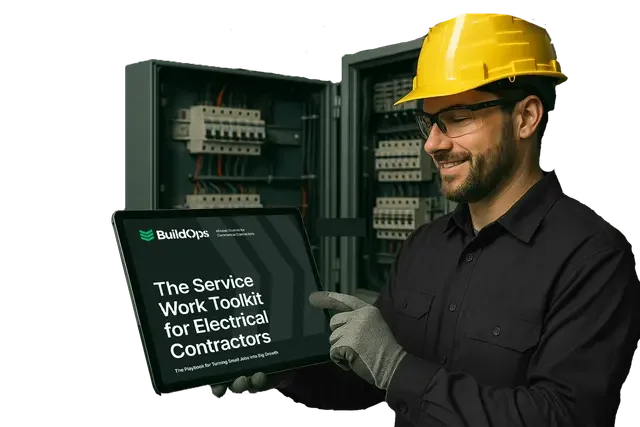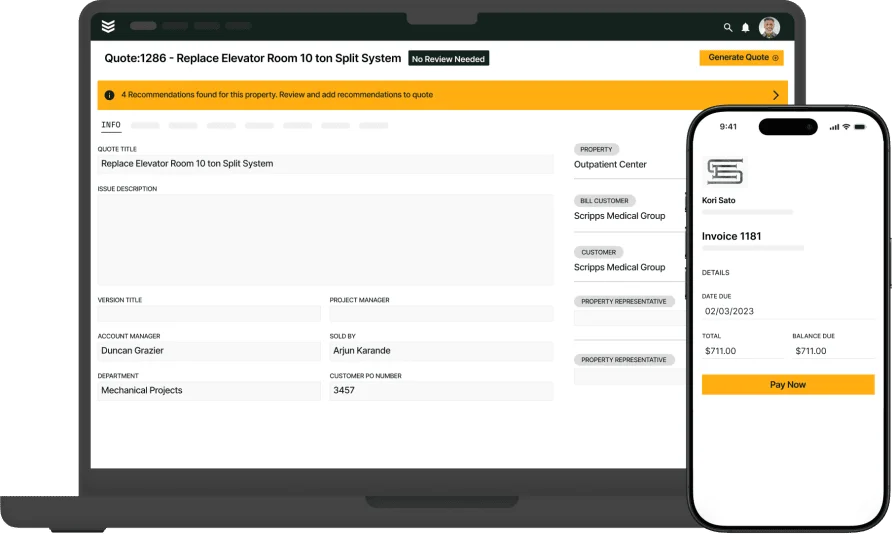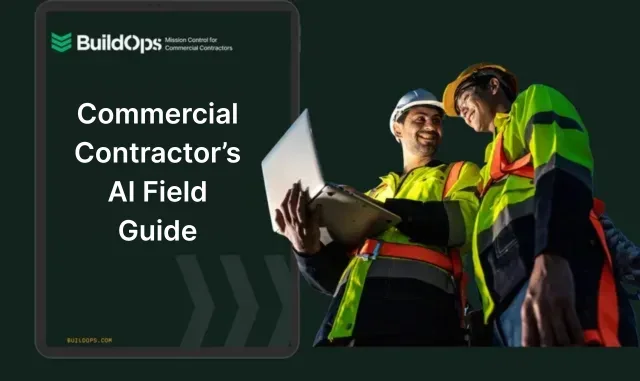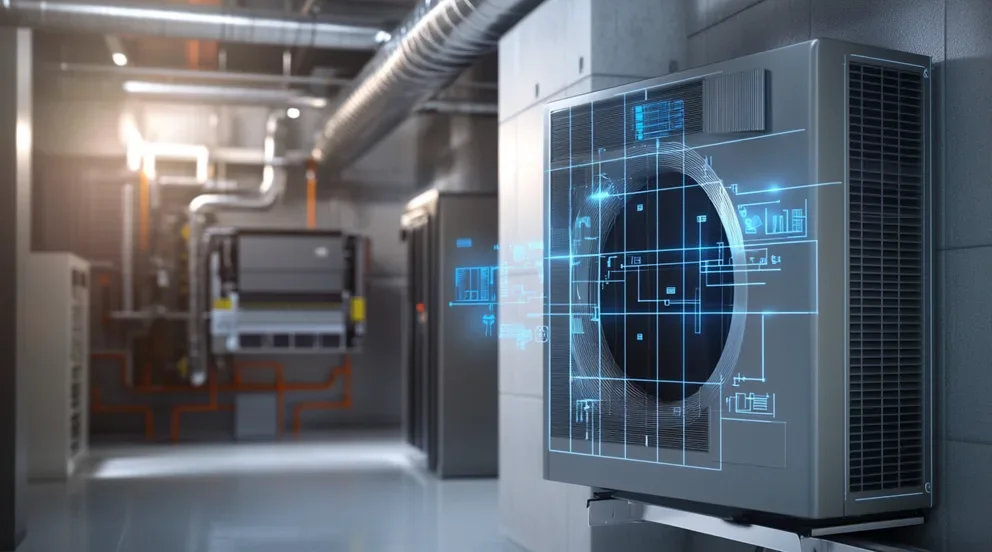Every electrical job starts with a number. And getting that number right—fast—can make or break your margins. If you're still piecing together estimates with spreadsheets or outdated systems, it's time for a serious upgrade. Contractors across the electrical industry are turning to AI-powered tools that cut guesswork, speed up bids, and help crews win more work. This guide breaks down how AI electrical estimating software works, why it's gaining traction, and what features matter most when choosing a tool for your team.
Whether you’re quoting complex installations or managing recurring service work, the right AI solution can transform how you estimate—and how you operate. Here’s what we’ll cover:
- How AI has impacted electrical estimating software
- Choosing the right AI electrical estimating software for your team
- 5 key AI features to look for in an electrical estimating software
- Top 6 AI electrical estimating software and tools for contractors
- 7 benefits of using AI-based electrical estimating software
- 4 common AI estimating software FAQs answered for electrical contractors
AI has already started shifting how contractors handle takeoffs, pricing, and bid prep. What used to take hours can now happen in minutes—with more accuracy and fewer surprises. Up next, we’ll break down exactly how AI is changing the game in electrical estimating software, and why it matters for your bottom line.
How AI has impacted electrical estimating software
Estimating electrical jobs has always been a grind—manual takeoffs, complex assemblies, fluctuating material costs, and constant spec changes. Traditional electrical estimating software helped streamline those tasks, but it still left contractors juggling disconnected tools and rechecking numbers across multiple systems.
Now AI is stepping in and cleaning up the mess. Instead of relying on static templates or manually entered data, AI electrical estimating tools learn from past estimates, spot patterns, flag inconsistencies, and adapt in real time. They cut down the busywork, helping estimators build more accurate bids—faster. You’re not just getting a calculator; you’re getting a system that thinks through the estimate with you.
With AI electrical estimating software, everything stays connected. Job specs, labor rates, takeoff data, and supplier pricing feed into one smart platform that evolves with every project. It doesn’t replace the estimator—it sharpens their edge. You get faster turnaround, tighter numbers, and better chances of landing the job without sacrificing margin.
Choosing the right AI electrical estimating software for your team
Every shop has its own way of doing things—but when it comes to AI electrical estimating software, the stakes are too high to pick blindly. You’re not just buying a tool; you’re setting the foundation for faster bidding, tighter margins, and fewer headaches down the line. Before you commit, it’s worth slowing down and asking the right questions that match how your team works in the field and in the office.
- Workflow compatibility – Will this software fit into how your estimators already work? Does it support both fast-turn bid requests and detailed, spec-heavy quotes?
- Training and learning curve – How quickly can your crew pick this up? Will your junior estimators be able to use the AI tools without needing constant hand-holding?
- Data integration – Can the platform pull in live material pricing, supplier catalogs, or past job history? Will it play nice with your accounting or project management software?
- Scalability – Will it still work when your job count doubles? Does it support multiple estimators working on the same project without stepping on each other?
- Features – Are the features actually useful in the field? Can estimators adjust labor units, apply assemblies, or auto-generate takeoffs with AI help?
Once you’ve nailed down how the software fits into your team’s workflow, it’s time to dig into what the tool actually does. Not all features are created equal—especially when AI is involved. Up next, we’ll break down the key AI features you should look for in AI electrical estimating software that can actually make life easier for your estimators and give your bids an edge.

Quote jobs precisely
Streamline estimating to quote jobs more accurately.
5 key AI features to look for in an electrical estimating software
Electrical estimating covers a lot of ground—pricing out labor, managing specs, juggling vendor quotes, and tracking every change. AI helps contractors handle all that without slowing down. By learning from past jobs and syncing real-time data across the board, it makes your estimates sharper, faster, and easier to manage from start to finish. If you’re bidding tight timelines or managing repeat business, these features can make all the difference.
1. CRM
A strong CRM keeps your team organized and your pipeline moving. In AI electrical estimating software, it automatically records every customer interaction, tracks project milestones, and even suggests next steps based on what’s worked in the past. Estimators stay focused on active jobs while AI handles the follow-ups and context switching behind the scenes. Say your estimator is preparing a proposal for a commercial buildout where the client has worked with your team before.
With an AI-powered CRM for electrical contractors, they can instantly pull up the full history—quotes, notes, material costs, and labor data—so nothing gets missed. The estimate gets built with context already in place, not from scratch.
2. Invoicing and payments
AI-powered estimating doesn’t stop when the quote is sent—it connects to invoicing and payment tools to keep billing accurate and fast. These tools sync with estimate data to auto-generate invoices and track what’s been paid or flagged. Fewer billing mistakes means fewer calls back from clients.
Picture wrapping up a job, only to have billing lag two weeks behind. With integrated invoicing and payments tools, the system pulls line items straight from the estimate, tracks adjustments, and helps your office send clean, correct invoices fast. Less back-and-forth, more cash flow.
3. Mobile field tech app
AI electrical estimating works best when it’s tied to the field. A dedicated app for field techs gives them access to takeoffs, scope notes, and real-time updates—right from the job site. AI can flag incomplete line items or cost anomalies, giving your techs and estimators a feedback loop that keeps the bid accurate all the way through the install.
Let’s say your crew is in the middle of a panel upgrade and runs into a mismatch with materials. Through a mobile app for field technicians, the field tech flags the issue, and AI suggests alternate parts based on supplier pricing and previous projects. That update flows back into the estimator’s scope in real time.
4. Reporting and analytics
AI turns estimates into insight. By analyzing past projects, AI-powered reporting tools highlight trends, labor costs, material markups, and win rates. Estimators can adjust strategies on the fly—and business owners can see what’s really driving profit or drag.
For example, if your team keeps losing margin on retrofit jobs, reporting and analytics tools can break down where the gaps are—labor hours, parts markup, or scope creep. AI then offers recommendations to tighten those numbers in future bids.
5. Service agreements
When you manage recurring maintenance or multi-site service plans, AI simplifies the way you estimate and track contract work. It uses historical job data to forecast costs, schedule service, and flag unusual patterns that could impact profit.
Think of a property manager who wants quarterly service on 12 locations. With an AI-driven service agreement management tool, your team can generate a multi-phase estimate using real job history. AI projects costs, flags outdated rates, and adjusts timelines based on your crew’s availability—so every detail is locked in before you send the proposal.
Other valuable features to look for in AI-powered electrical estimating software
Beyond the essentials, there are a few additional features that round out a strong AI electrical estimating platform. These tools support speed, clarity, and better handoffs between estimating, scheduling, and execution—especially when multiple jobs are moving at once.
- Scheduling: When integrated with estimating, field service scheduling software for electrical contractors can align projected timelines with available resources. AI uses past job durations and crew performance to recommend optimal schedules from the moment the estimate is generated.
- Time tracking: Time tracking tools help validate estimates by feeding actual labor data back into the system. AI compares quoted hours with real job times to fine-tune future bids—making your estimates more accurate over time.
- Pipeline management: Estimating teams need visibility into which jobs are in progress, which are pending approval, and which are cold. A project pipeline tracker powered by AI helps sort, score, and prioritize opportunities based on real engagement metrics and historical outcomes.

Check out our service work toolkit
Tighten up how your crew handles quotes, bids, and day-to-day service jobs.
Even with powerful features behind the scenes, the tool you choose still needs to work in real-world conditions—across job types, team sizes, and project scopes. Not every platform hits the same mark when it comes to electrical work, AI functionality, or estimating accuracy. Up next, we’ll break down six standout options for AI electrical estimating software, so you can see how they stack up for different types of contractors.
Top 6 AI electrical estimating software and tools for contractors
No two electrical contractors operate exactly the same way. Some juggle large-scale commercial builds, others focus on residential service calls, and plenty fall somewhere in between. Choosing AI electrical estimating software that matches your day-to-day work is key. Here’s a breakdown of six options that stand out—each with strengths for a specific type of contractor.
1. Best for commercial: BuildOps
BuildOps was created for commercial contractors dealing with high-volume estimating and complex installs. Its AI-driven tools help estimators generate fast, accurate quotes using real-time material pricing, historic job data, and labor benchmarks. But it doesn’t stop at the estimate. BuildOps uses AI to support the entire post-bid workflow—automating invoice summaries, scanning receipts for job-related costs, and even filling in purchase order fields based on the estimate scope. That means less paperwork, fewer errors, and tighter back-office coordination.
How pricing works: BuildOps uses custom pricing based on company size and number of users. Estimates are tailored per team, so you only pay for what your operation actually needs.
Features beyond estimating: In addition to AI-enhanced quoting, BuildOps includes dispatch management, technician mobile apps, CRM tools, automated service agreement tracking, and full reporting dashboards. Every tool feeds into estimating, creating a closed-loop system that improves with every job.
What sets it apart for commercial contractors: Commercial estimators can track labor units, materials, and change orders in real time while AI continuously adjusts cost projections. When the job kicks off, the same system auto-generates POs, summarizes invoices by project, and ties scanned receipts to job codes. Everything’s connected—saving your team hours each week and reducing missed revenue.

Level up your quoting process
Precisely quote your electrical jobs so you win more jobs—and get paid fast.
2. Best for residential: Housecall Pro
Image Source: Housecall Pro
Housecall Pro is built around simplicity. Its clean interface makes it a solid pick for small residential electrical shops that prioritize fast quoting and tight scheduling. It automates basic estimating tasks and helps owners manage field techs, appointments, and invoices with minimal training. However, it may not offer the AI depth or commercial-grade customization some contractors need.
How pricing works: Tiered monthly pricing, starting around $59/month, depending on the number of users and access to features.
Features beyond estimating: Includes online booking, automatic follow-ups, payment processing, and customer communication tools. You also get a mobile app that keeps your field team in sync with office dispatch and scheduling.
What sets it apart for residential contractors: For shops handling dozens of home service calls a week, Housecall Pro keeps operations streamlined. Estimators can quickly generate quotes and convert them into jobs with just a few clicks.
3. Best for general contractors: Jobber
Image Source: Jobber
Jobber focuses on helping general contractors manage clients, quotes, jobs, and payments in one place. Its estimate builder is easy to use and comes with templates that save time. For electrical contractors doing mixed trade work or partnering on GC-led projects, it’s a flexible choice. That said, its AI capabilities and deep estimating features may feel limited for larger or specialized electrical teams.
How pricing works: Starts at $25/month for one user, with pricing tiers based on feature access and user count.
Features beyond estimating: Offers client communication tools, mobile job tracking, appointment scheduling, and basic reporting. The integrations are solid, but geared more toward general field service than advanced electrical workflows.
What sets it apart for general contractors: Jobber gives GCs visibility across all job stages without needing complex setups. For teams wearing multiple hats—estimating, managing, dispatching—it offers a centralized place to stay organized.
4. Best for small to mid-sized businesses: Workiz
Image Source: Workiz
Workiz is built for smaller teams that need fast turnaround on estimates, scheduling, and invoicing without dealing with complex setup. It features voice-to-text quoting, smart scheduling, and AI-powered follow-ups—ideal for growing electrical shops that juggle multiple jobs at once. That said, its customization and depth may feel limited for commercial contractors or teams handling more advanced installations.
How pricing works: Workiz offers tiered pricing starting at around $65/month, depending on user count and features included.
Features beyond estimating: Workiz includes built-in VoIP calling, team messaging, calendar syncing, and technician GPS tracking. These features help owners keep tight control of job progress without bouncing between apps.
What sets it apart for small to mid-sized teams: Workiz makes it easy for lean electrical teams to manage estimates and jobs in one place. The AI tools help keep estimates moving without chasing down client approvals or rescheduling manually.
5. Best for independent contractors: McCormick Systems
Image Source: McCormick
McCormick Systems is a longtime name in the electrical estimating world, especially for detailed material pricing and takeoff workflows. The platform offers AI-assisted takeoff tools, integration with vendor catalogs, and bid tracking dashboards. However, the user interface can feel dated, and it may require more training time compared to newer platforms.
How pricing works: Pricing is customized based on licenses and modules. Estimates start in the mid-hundreds for entry-level systems, with add-ons for advanced takeoff or service work.
Features beyond estimating: McCormick includes built-in labor units, spec book syncing, and preloaded assemblies—especially helpful for contractors doing specialized electrical work or prefabrication.
What sets it apart for independent contractors: Solo contractors and small teams benefit from McCormick’s deep catalog and takeoff automation. The AI tools make solo estimating faster, though the platform may feel bulky for quick turnaround work.
6. Best for installation & maintenance contractors: PlanSwift
Image Source: PlanSwift
PlanSwift specializes in digital takeoff and plan review, giving estimators the tools to measure, mark up, and generate material lists directly from blueprints. AI helps flag inconsistencies, auto-suggest labor needs, and refine takeoffs as new plans come in. While powerful for install-focused work, it lacks broader job management features like CRM or scheduling.
How pricing works: One-time license cost starting at roughly $2,000, with optional yearly maintenance and add-on modules.
Features beyond estimating: Includes drag-and-drop assemblies, measurement tools, Excel integration, and plugins for supplier pricing. It also offers customizable formulas for job costing.
What sets it apart for installation and maintenance teams: PlanSwift shines when jobs are blueprint-heavy and demand precise takeoff work. For contractors focused on installs, AI-enhanced takeoff paired with accurate labor mapping helps produce sharp estimates—even on tight timelines.
7 benefits of using AI-based electrical estimating software
Electrical estimating used to mean long hours chasing down data and cross-checking numbers manually. But AI changes how information flows across your business—saving time, reducing risk, and making your estimates smarter with every job. Here’s how AI-backed estimating software delivers practical benefits for field service electrical contractors.
1. Faster, more accurate bidding
AI takes what your team already knows—past jobs, common assemblies, supplier pricing—and plugs it into the estimate automatically. As scope details shift, the system adjusts in real time, keeping your numbers solid even as specs evolve. This type of automation lines up with estimating methods used in electrical contractor bidding, where speed and clarity make all the difference.
2. Smarter lead handling
Instead of flipping between your CRM and your estimate builder, AI syncs the two—sorting which jobs are heating up, flagging old quotes worth revisiting, and logging every touchpoint without the manual input. These are common in electrical contracting CRM workflows that rely on steady quoting volume and fast follow-ups to stay competitive.
3. Instant insights from past estimates
AI doesn’t forget how your last job went. It tracks which assemblies ran over, which vendors delivered on time, and where margin got tight. That history flows directly into new bids, helping you fine-tune without starting from zero. You’ll see this kind of learning curve play out in electrical bid examples where real-world job history shapes how contractors quote the next one.
4. Fewer billing mistakes
When AI ties the estimate to labor tracking and material usage, billing gaps get flagged before they hit your client. Whether it’s a missed change order or a line item that wasn’t updated, the system surfaces it early. This kind of syncing between estimate and invoice is common in electrical businesses that follow practices similar to those found in electrical contractor billing systems, where quoting accuracy directly affects how fast you get paid.
5. AI-driven job forecasting
A solid estimate sets the tone for the entire job. AI looks at current workloads, lead times, and field crew availability to help you spot timeline issues before the first truck rolls. These kinds of forecasting insights are now showing up across AI applications in field service, where they help electrical teams avoid surprises and rebalance resources on the fly.
6. Stronger close rates
Clean, fast quotes win jobs. When AI helps break out costs clearly—without the usual spreadsheet juggling—clients get the full picture quicker. That transparency builds confidence, especially in competitive bidding where response time and accuracy can make or break the deal.
7. Less admin, more estimating
Estimators spend too much time chasing down part numbers, correcting old templates, and checking math. AI handles the repetitive stuff—pulling in job history, matching item codes, filling in spec sheets—so your team can focus on strategy, not spreadsheets.
4 common AI estimating software FAQs answered for electrical contractors
AI estimating software can sound like a buzzword—until you see how it changes the day-to-day for electrical contractors. These tools aren’t just digital calculators. They help your team quote faster, track job data smarter, and close more work. Here are the answers to the most common questions field crews and estimators are asking.
1. What is AI electrical estimating software?
AI electrical estimating software is a digital platform that uses artificial intelligence to generate faster, more accurate estimates for electrical jobs by analyzing job history, material databases, and real-time project inputs. It helps contractors reduce manual input and improve bid precision.
Most platforms combine traditional estimating workflows—like takeoffs, material lists, and labor costs—with AI features that automate repetitive steps. That includes learning from past jobs, flagging anomalies in real-time quotes, and syncing project data across the field and office. The result is fewer errors, quicker turnaround, and estimates that reflect real-world job conditions.
2. How does AI-powered estimating software for electrical contractors work?
AI estimating software works by using algorithms to analyze data from past jobs, material pricing, labor rates, and real-time project inputs. It learns how your team builds quotes and helps automate parts of that process—reducing guesswork and manual steps.
Here’s what it typically does:
- Analyzes historical job data to predict labor and material needs
- Auto-fills common assemblies and part combinations
- Flags inconsistencies or missing data in estimates
- Syncs takeoffs with live supplier pricing
- Tracks estimate revisions and customer feedback in real time
- Connects with field tools to keep scope aligned during the job
AI helps estimators focus on higher-value decisions by handling the repetitive tasks and ensuring quotes are based on real project performance—not just templates.

See our AI Field Guide
Learn how AI can superpower your electrical estimating tool for better accuracy.
3. Is estimating software worth the cost for electrical contractors?
Yes—especially when it includes AI features that speed up turnaround time and improve estimate accuracy. For small shops, it cuts down on admin hours. For larger teams, it creates consistency across estimators and ties together workflows from estimating through job execution.
What you spend on the software is often offset by time saved, fewer errors, and higher win rates. A clean, fast quote can be the difference between landing a job or losing it. And when the platform catches mistakes before they hit the client or the field, you avoid costly rework down the line.
Did you know
Our customer Jolma Electric certainly thought so when they saw a 50% spike in efficiency after using BuildOps.
4. Best practices for implementing AI-powered electrical estimating software
Rolling out AI estimating tools doesn't have to be disruptive—but it does take a plan. The best results come when teams know what to expect and how to use the tools day-to-day. Here are 8 solid practices to follow:
- Identify your top estimating pain points before rollout
- Start with one estimator or crew before scaling across the team
- Train your team on both the estimating side and field connections
- Clean up your job history and data inputs—the AI relies on it
- Create consistent templates or assemblies to build from
- Use feedback loops—get input from field techs on scope accuracy
- Set up reporting so you can track improvements and ROI
- Stay flexible—tweak workflows as your team adapts
With the right setup, AI estimating software doesn’t just save time—it helps your team quote smarter and build with more confidence.
For electrical contractors, estimating has always been a moving target—between labor changes, material costs, and job complexity, there’s a lot to track. AI doesn’t just help you keep up—it gives you a better way to get ahead. Whether you're quoting installs, bidding on service agreements, or tracking margin on repeat work, the tools we covered help eliminate guesswork and close the gaps that usually cost time and money.
Most platforms offer one or two of these features. What makes BuildOps different is how everything works together—estimating, invoicing, CRM, and scheduling all under one roof, built specifically for commercial field service contractors. And yes, it includes the AI features other tools skip over.

See how BuildOps can help
Automate quoting for greater accuracy and more closed deals.








